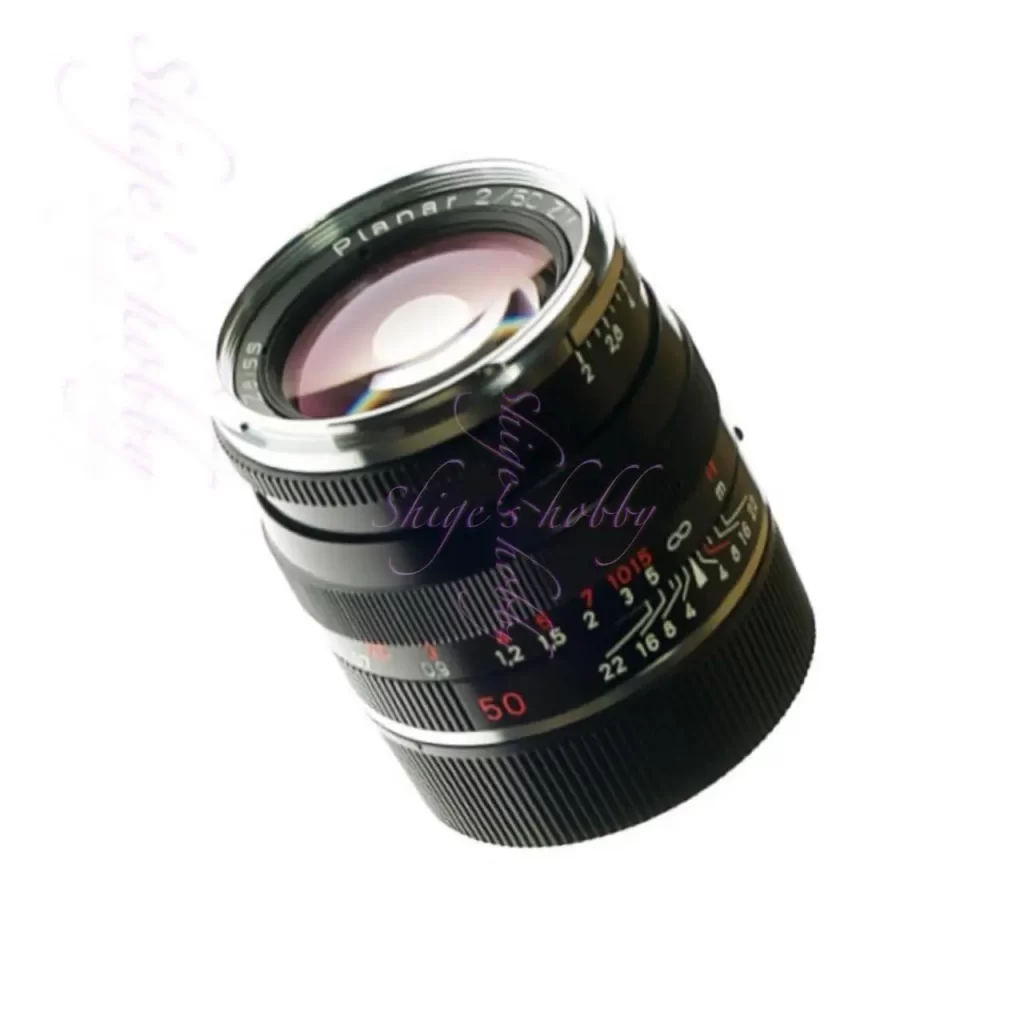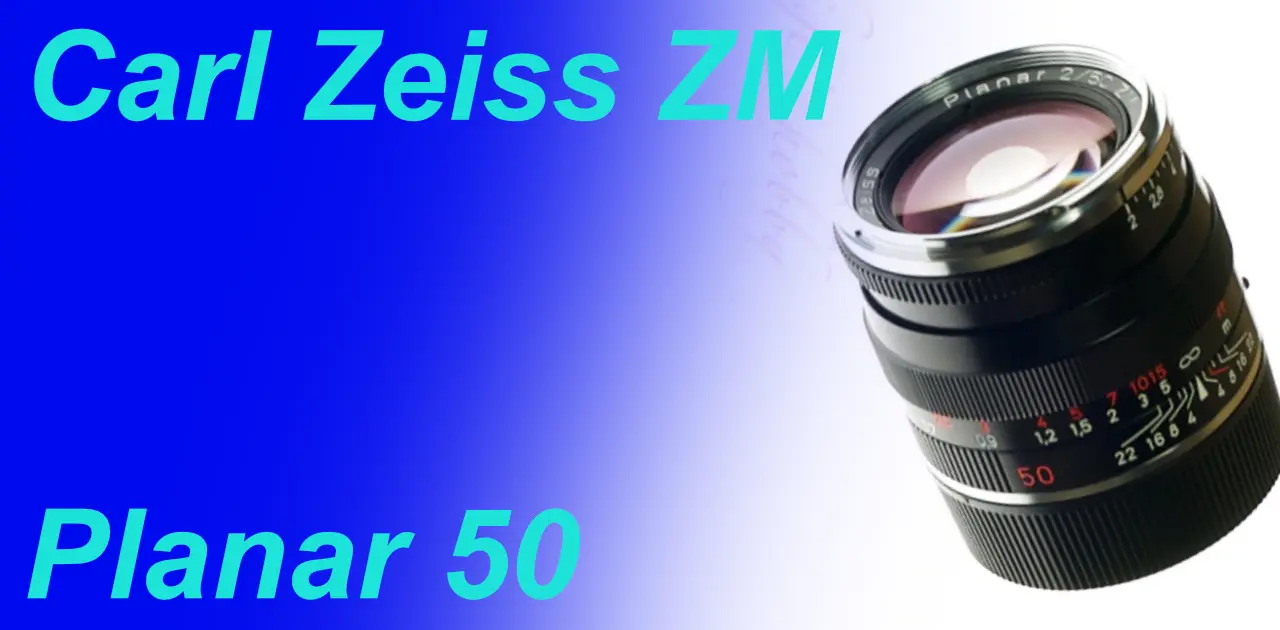Last updated on 2025-08-01
A review and photo examples of using the Carl Zeiss Planar ZM 50mm with film and digital cameras.
- Please see the disclaimer regarding advertising here.
- Italicized links in the text are advertisement links that take you to other sites.
Table of contents
Gallery
The sample photos were taken with HEXAR RF + KODAK EKTACHROME 64 (EPR) and EPSON R-D1.
Review

1.Overview
The Planar 50mm F2 ZM is a standard lens manufactured by Cosina under the Carl Zeiss brand, released on January 15, 2005.
Its main specifications are a 4-group, 6-element Gaussian configuration, 8 aperture blades, and a minimum shooting distance of 0.7m.
A dedicated bayonet hood, the Lens Shade 35/50mm, is available for 7,500 yen (excluding tax) JAN 4530076 855359, which is the same as the BIOGON 35mm F2, released at the same time.
The Planar 50mm F2 ZM is a monumental lens that officially marks the launch of the CARL ZEISS brand into the Leica M mount.
ZEISS had been actively licensing the ZEISS brand to Sony, Cosina, and others for several years before the release of this lens, but I was surprised to see that this had been expanded to lenses for the Leica M mount when the lens was released.
2.Usability
I bought the Planar 50mm F2 ZM at the now defunct Chikuma Shokai in Kannai as soon as it was released.
I used this lens with both film and digital cameras, and when I looked at the sleeves of the reversal film shots on a light box, I was impressed by the sharp depiction of the landscape photos of cherry blossoms.
This was the era of digital cameras, the Epson R-D1 and the Leica M8, both of which had sensors smaller than 35mm full-frame sensors, with the R-D1 having a focal length equivalent to 75mm in 35mm format and the M8 having a focal length equivalent to 65mm, making the R-D1 feel a bit cramped.
The lens construction is a standard double Gauss type with an orthodox structure. Thanks to the evolution of the coating and improved manufacturing precision, it feels like a lens with high basic performance.
3.Summary
The Planar 50mm F2 ZM is one of the best M-mount 50mm prime lenses I’ve used since I started using non-Leica cameras, and it’s one of the best lenses in terms of cost performance. It’s versatile enough to be used with both digital and film cameras, and it’s been a useful standard lens for me for a long time.
Specification and Competitor
The difference between the lens configuration diagrams of the Planar 50mm ZM and the C Sonnar 50mm ZM is clear when you compare them side by side. The Sonnar has a recessed rear lens element, which allows the lens barrel to be made compact, and it is a lens configuration suitable for rangefinders.
- The lens construction diagrams are quoted from each company’s materials, and the sizes have been adjusted by us, so they are not exact.
| Items | Planar | C Sonnar |
| Focal length(mm) | 50 | 50 |
| Max aperture | 2 | 1.5 |
| Min aperture | 22 | 16 |
| Lens Construction | 4群6枚 | 4群6枚 |
| Min distance(m) | 0.7 | 0.9 |
| Lens length(mm) | 43.5 | 38.2 |
| Max diameter(mm) | 52 | 55.6 |
| Filter Size(mm) | 43 | 46 |
| Weight(g) | 210 | 250 |
| Release date | 2005.1.15 | 2006.8.4 |
| Price(Yen/No-tax) | ¥75,000 | ¥105,000 |
ZM Lens list
- Distagon T✻ 15mm ƒ/2.8 (Made in Germany)
- Distagon T✻ 18mm ƒ/4
- Distagon T✻ 21mm ƒ/2.8
- C Biogon T✻ 21mm ƒ/4.5
- Biogon T✻ 25mm ƒ/2.8
- Biogon T✻ 28mm ƒ/2.8
- Distagon T✻ 35mm ƒ/1.4
- Biogon T✻ 35mm ƒ/2
- C Biogon T✻ 35mm ƒ/2.8
- C Sonnar T✻ 50mm ƒ/1.5
- Planar T✻ 50mm ƒ/2
- Tele-Tessar T✻ 85mm ƒ/4
- Sonnar T✻ 85mm ƒ/2 (Made in Germany)
Reference links
Update history
- 2025.1.29
- 2024.04.20:Update the article
- 2023.11.02:First draft
Affiliate link
- Please see the disclaimer regarding advertising here.
- Italicized links in the text are advertisement links that take you to other sites.
- LEICA lens・Ads by Amazon
- Zeiss lens・Ads by Amazon
- ZEISS PLANAR 50mm・Ads by Amazon
- Carl Zeiss Lens Shade 35/50mm・Ads by Amazon




![[商品価格に関しましては、リンクが作成された時点と現時点で情報が変更されている場合がございます。] [商品価格に関しましては、リンクが作成された時点と現時点で情報が変更されている場合がございます。]](https://hbb.afl.rakuten.co.jp/hgb/0927c0bf.13e6bb27.0927c0c0.ff3f4621/?me_id=1180385&item_id=10004728&pc=https%3A%2F%2Fthumbnail.image.rakuten.co.jp%2F%400_mall%2Fmitsuba%2Fcabinet%2Fikou_20100223_003%2Fimg10211365015.jpg%3F_ex%3D128x128&s=128x128&t=picttext)
![[商品価格に関しましては、リンクが作成された時点と現時点で情報が変更されている場合がございます。] [商品価格に関しましては、リンクが作成された時点と現時点で情報が変更されている場合がございます。]](https://hbb.afl.rakuten.co.jp/hgb/06ddf1d8.b245f6d5.06ddf1d9.44d5c3c5/?me_id=1202242&item_id=10043391&pc=https%3A%2F%2Fthumbnail.image.rakuten.co.jp%2F%400_mall%2Fmapcamera%2Fcabinet%2Fnew_015%2F4530076820562_1.jpg%3F_ex%3D128x128&s=128x128&t=picttext)
Be First to Comment